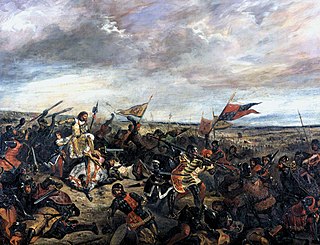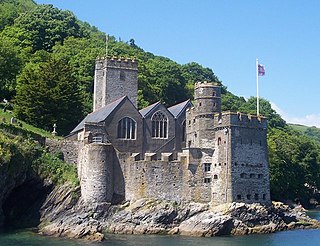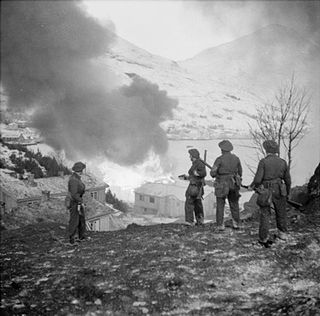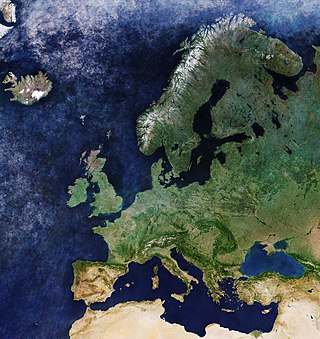
The Battle of Poitiers was fought on 19 September 1356 between a French army commanded by King John II and an Anglo-Gascon force under Edward, the Black Prince, during the Hundred Years' War. It took place in western France, 5 miles (8 km) south of Poitiers, when approximately 14,000 to 16,000 French attacked a strong defensive position held by 6,000 Anglo-Gascons.

The Battle of Agincourt was an English victory in the Hundred Years' War. It took place on 25 October 1415 near Azincourt, in northern France. The unexpected English victory against the numerically superior French army boosted English morale and prestige, crippled France, and started a new period of English dominance in the war that would last for 14 years until England was defeated by France in 1429 during the Siege of Orléans.

Year 1403 (MCDIII) was a common year starting on Monday of the Julian calendar.

Year 1404 (MCDIV) was a leap year starting on Tuesday of the Julian calendar.

The Battle of Crécy took place on 26 August 1346 in northern France between a French army commanded by King Philip VI and an English army led by King Edward III. The French attacked the English while they were traversing northern France during the Hundred Years' War, resulting in an English victory and heavy loss of life among the French.

The Battle of Sluys, also called the Battle of l'Écluse, was a naval battle fought on 24 June 1340 between England and France. It took place in the roadstead of the port of Sluys, on a since silted-up inlet between Zeeland and West Flanders. The English fleet of 120–150 ships was led by Edward III of England and the 230-strong French fleet by the Breton knight Hugues Quiéret, Admiral of France, and Nicolas Béhuchet, Constable of France. The battle was one of the opening engagements of the Hundred Years' War.

The Battle of Winchelsea or the Battle of Les Espagnols sur Mer was a naval battle that took place on 29 August 1350 as part of the Hundred Years' War between England and France. It was a victory for an English fleet of 50 ships, commanded by King Edward III, over a Castilian fleet of 47 larger vessels, commanded by Charles de la Cerda. Between 14 and 26 Castilian ships were captured, and several were sunk. Only two English vessels are known to have been sunk, but there was a significant loss of life.

James II of Bourbon-La Marche was count of La Marche. He was captured at the battle of Nicopolis in 1396, later being ransomed. In 1403, James led an attack on English soil and burned Plymouth. He married Queen Joanna II of Naples in 1415, and was largely unpopular being imprisoned then forced to leave the kingdom of Naples in 1419. James relinquished his titles and became a monk in 1435. He died in 1438.

The Battle of Blanchetaque was fought on 24 August 1346 between an English army under King Edward III and a French force commanded by Godemar du Fay. The battle was part of the Crécy campaign, which took place during the early stages of the Hundred Years' War. After landing in the Cotentin Peninsula on 12 July, the English army had burnt a path of destruction through some of the richest lands in France to within 20 miles (32 km) of Paris, sacking a number of towns on the way. The English then marched north, hoping to link up with an allied Flemish army which had invaded from Flanders. They were outmanoeuvred by the French king, Philip VI, who garrisoned all of the bridges and fords over the River Somme and followed the English with his own field army. The area had previously been stripped of food stocks by the French, and the English were essentially trapped.

Dartmouth Castle is an artillery fort, built to protect Dartmouth harbour in Devon, England. The earliest parts of the castle date from the 1380s, when, in response to the threat of a French attack, the civic authorities created a small enclosure castle overlooking the mouth of the Dart estuary. This was intended to engage enemy ships with catapults and possibly early cannon, and incorporated the local chapel of Saint Petroc within its walls. At the end of the 15th century, the castle was expanded with an artillery tower and an iron chain which could be stretched across the harbour to a tower at Godmerock; this addition formed the oldest known purpose-built coast artillery fort in Britain. Further gun batteries were added during the French invasion scare of the 1540s.

Raiding, also known as depredation, is a military tactic or operational warfare "smash and grab" mission which has a specific purpose. Raiders do not capture and hold a location, but quickly retreat to a previous defended position before enemy forces can respond in a coordinated manner or formulate a counter-attack. Raiders must travel swiftly and are generally too lightly equipped and supported to be able to hold ground. A raiding group may consist of combatants specially trained in this tactic, such as commandos, or as a special mission assigned to any regular troops. Raids are often a standard tactic in irregular warfare, employed by warriors, guerrilla fighters or other irregular military forces. Some raids are large, for example the Sullivan Expedition.

John Hawley of Dartmouth in Devon, was a wealthy ship owner who served fourteen times as Mayor of Dartmouth and was elected four times as a Member of Parliament for Dartmouth. He is reputed to have been the inspiration for Chaucer's "schipman". His magnificent monumental brass survives in St Saviour's Church, Dartmouth.

The Château de Ranton is a small fortified castle in the village of Ranton, in the Department of the Vienne just west of Loudun, and south of the Loire. It was one of the front line of fortresses which were built to defend the royal city of Loundun at the beginning of the Hundred Years' War in 1340–1345. It played this military role until 1372. It then became a feudal manor and one of the estates of aristocratic families associated with the Courts of the French Kings and the Dukes of Anjou.
Events from the 1400s in England.

Despite the rise of knightly cavalry in the 11th century, infantry played an important role throughout the Middle Ages on both the battlefield and in sieges. From the 14th century onwards, it has been argued that there was a rise in the prominence of infantry forces, sometimes referred to as an "infantry revolution", but this view is strongly contested by some military historians.

The Glyndŵr rebellion was a Welsh rebellion led by Owain Glyndŵr against the Kingdom of England during the Late Middle Ages. During the rebellion's height between 1403 and 1406, Owain exercised control over the majority of Wales after capturing several of the most powerful English castles in the country, and formed a parliament at Machynlleth. The revolt was the last major manifestation of Welsh independence before the annexation of Wales into England in 1543.

Invasions of the British Isles have occurred several times throughout their history. The British Isles have been subject to several waves of invasion and settlement since humans began inhabiting the region approximately 900,000 years ago during the Paleolithic. Notable invasions of the British Isles including the Roman conquest of Britain, Viking expansion, the Norman Conquest, the Anglo-Norman invasion of Ireland and the Glorious Revolution.
The Battle of Valmont is the name given to two connected actions which took place between 9 and 11 March 1416 in the area of the towns of Valmont and Harfleur in Normandy. A raiding force under Thomas Beaufort, Earl of Dorset, was confronted by a larger French army under Bernard VII, Count of Armagnac at Valmont. The initial action went against the English, who lost their horses and baggage. They managed to rally and withdraw in good order to Harfleur, only to find the French had cut them off. A second action now took place, during which the French army was defeated with the aid of a sally from the English garrison of Harfleur.
William Wilford, of Exeter, Devon, was an English politician.
Events from the year 1404 in France

















